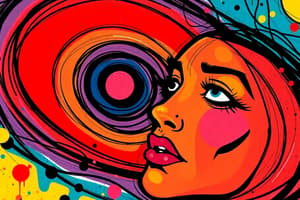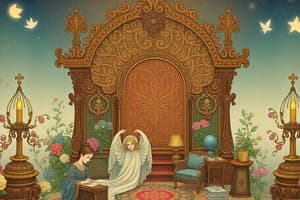Podcast
Questions and Answers
¿Cuál es el propósito principal de la historieta como forma de narrativa?
¿Cuál es el propósito principal de la historieta como forma de narrativa?
- Combinar texto e imágenes para transmitir información
- Crear una experiencia de lectura interactiva
- Contar historias secuenciales y cohesionadas (correct)
- Mostrar la habilidad artística del autor
¿Dónde se adaptó la historieta a los gustos y estilos locales?
¿Dónde se adaptó la historieta a los gustos y estilos locales?
- En África, en países como Sudáfrica y Nigeria
- En Asia, particularmente en Japón y Corea
- En Estados Unidos y Europa
- En América Latina, especialmente en Argentina y México (correct)
¿Cuál es el papel del arte en la historieta?
¿Cuál es el papel del arte en la historieta?
- Crear un estilo visual único (correct)
- Ilustrar la portada de la historieta
- Añadir texto a las imágenes
- Describir la trama de la historia
¿Cuál es una característica común de los personajes en la historieta?
¿Cuál es una característica común de los personajes en la historieta?
¿Qué década fue considerada la 'edad de oro' de la historieta?
¿Qué década fue considerada la 'edad de oro' de la historieta?
¿Cuál es la función principal del dibujo en la historieta?
¿Cuál es la función principal del dibujo en la historieta?
¿Qué tipo de dibujo se caracteriza por utilizar formas y figuras exageradas o distorsionadas?
¿Qué tipo de dibujo se caracteriza por utilizar formas y figuras exageradas o distorsionadas?
¿Qué depende la calidad del dibujo en la historieta?
¿Qué depende la calidad del dibujo en la historieta?
¿Cuál es el efecto principal que se busca con el dibujo caricaturesco en la historieta?
¿Cuál es el efecto principal que se busca con el dibujo caricaturesco en la historieta?
¿Por qué es esencial el dibujo en la historieta?
¿Por qué es esencial el dibujo en la historieta?
Study Notes
Narrativa
- Historieta is a form of narrative that combines text and images to tell a story.
- The narrative is often sequential, with each panel or frame building on the previous one to create a cohesive story.
- The use of visual elements allows for a unique storytelling experience, with the ability to convey emotions and tone through artwork.
Historia del Cómic
- Historieta has its roots in the early 20th century, with the development of comic strips in the United States and Europe.
- The format gained popularity in Latin America, particularly in Argentina and Mexico, where it was adapted to local tastes and styles.
- The 1960s and 1970s saw a golden age of historieta, with the rise of iconic characters and series.
Dibujo
- The artwork in historieta is a crucial element of the narrative, with detailed illustrations and dynamic layouts.
- Artists often use a range of techniques, including line art, shading, and color, to create a unique visual style.
- The use of visual metaphors and symbolism adds depth and complexity to the storytelling.
Personajes
- Characters in historieta are often complex and multi-dimensional, with rich backstories and motivations.
- Heroes and villains are common, with many series featuring iconic characters that have become part of popular culture.
- The use of character development and relationships adds emotional depth to the narrative.
Géneros
- Historieta encompasses a range of genres, including:
- Acción/Aventura: fast-paced, action-packed stories often featuring superheroes or heroic characters.
- Ciencia Ficción: science fiction stories that explore alternate worlds and technologies.
- Fantasía: fantasy stories that incorporate magical or supernatural elements.
- Romance: romantic stories that focus on relationships and emotional drama.
- Terror: horror stories that aim to scare or unsettle the reader.
Studying That Suits You
Use AI to generate personalized quizzes and flashcards to suit your learning preferences.
Description
Explore the world of historieta, a unique form of narrative that combines text and images to tell a story. Learn about its history, characteristics, and genres. Discover the art of visual storytelling!




